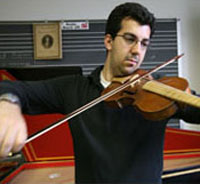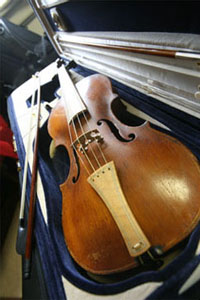Student Brings Authentic Period Instrument to Ensemble
 Hurdy-gurdies, lutes and the occasional sackbut: For 14 years,
the College of William and Mary’s Early Music Ensemble has brought
medieval, renaissance and baroque music to life with reproductions of
instruments such as these.
Hurdy-gurdies, lutes and the occasional sackbut: For 14 years,
the College of William and Mary’s Early Music Ensemble has brought
medieval, renaissance and baroque music to life with reproductions of
instruments such as these.
But never had a genuine survivor of its time made its way to the ensemble -- that is, until recently when a self-described “baroque music snob” broke all of his own rules and found the real thing online.
Nick Fitzgerald, a junior at William and Mary, came to the school with a love for early music and nearly a decade of experience in playing the violin. When he joined the College’s Early Music Ensemble, he took his modern instrument and “made it as baroque as possible,” he said. He replaced the steel strings with gut, took off the chin and neck rests and bought a reproduction baroque bow. But even with all the tweaks, he felt it would never be quite the same as the real thing.
 And so the business and marketing major began looking for an
authentic 18th-century violin. He knew that finding one he could afford
was a challenge. Though he was of the opinion that no one should ever
buy an instrument – antique or other – from eBay, Fitzgerald checked
the online auction site on a whim one summer day last year.
And so the business and marketing major began looking for an
authentic 18th-century violin. He knew that finding one he could afford
was a challenge. Though he was of the opinion that no one should ever
buy an instrument – antique or other – from eBay, Fitzgerald checked
the online auction site on a whim one summer day last year.
“Much to my surprise, I typed in ‘baroque violin’ and this beautiful 18th-century instrument pops up,” he said.
The seller had professional pictures taken of the instrument and included a great deal of detail in the description. Fitzgerald contacted the seller – a violin dealer in California – for further information and told him that he’d only join the bidding if he could get the instrument authenticated with the opportunity to return it. The seller agreed and Fitzgerald entered the bidding, winning out in the very end of the auction.
“It was one of those things where you come in at the last second,” he said.
A Work of Art
Fitzgerald paid $2,100 for the violin. When he had the instrument checked out with an expert in Washington D.C., it was confirmed that the piece was made in the late 18th-century and probably in Germany. The estimated value, the expert told him, was somewhere between $7,000 and $10,000.
“It really is a work of art,” said Fitzgerald. “It really is much more than an instrument, and to know that it’s that old is kind of cool. It’s not something that everybody has.”
Though the untrained eye may not immediately be able to tell the authentic instrument apart from a modern violin, there are several differences. For instance, on a modern violin, the angle of the neck is sharp whereas on a baroque violin, it’s more at the level of the body. The position of neck affects the tension on the strings and the way the bridge sits, said Fitzgerald. Additionally, the baroque instrument’s body is a little smaller and lighter than the modern counterparts and its bridge is thinner and wider than modern bridges. Even the bows are different, said Fitzgerald.
“I found it was a little more difficult to isolate one string at a time because the fingerboard is not as rounded as a modern fingerboard, but that’s why you have a baroque bow,” he said, pointing out that the baroque bow is convex where the modern is concave.
The 18th-Century Difference
Fitzgerald said that all of those seemingly small variations add up to a big difference in the instrument’s tone quality and sound, making the baroque violin sound much “warmer and a little more earthy,” he said.
“That’s part of why I like it. It’s a much more accessible sound to the listener,” Fitzgerald said.
After Fitzgerald had a few minor adjustments made, the 18th-century violin made its debut with the College’s Early Music Ensemble during the fall 2007 semester. Fitzgerald said that he immediately noticed the difference in how the instrument sounded with the others.
“With the modern copy of baroque flute, now that I have this baroque instrument, we match much better and the tone quality is much more similar,” he said. “So it really does make a difference when you are playing on baroque instruments as opposed to modern instruments.”
Ruth van Baak Griffioen, an adjunct professor of music and director of the ensemble, has worked with early music students for 30 years. Though many of her students have had reproduction period instruments, Fitzgerald is the first of her students to have an authentic period instrument.
"I am stunned that, first of all, this interest was passed to a student so that they would go through all the effort of finding the instrument," she said. "and secondly, just the wonderful bit of entrepreneurial adventuresomeness to go out and find it the way he did."
Griffioen said that having an authentic piece in the ensemble just adds to the experience that the ensemble provides.
“There’s just a thrill in knowing that this instrument is as old as the music that we’re playing and almost as old as the buildings we are lucky enough to play in here in Williamsburg,” she said.
Bringing Performances to Life
Fitzgerald said it is the convergence of talents in the ensemble that bring their performances to life and draw packed audiences to their programs. However, having a real 18th-century violin does add a dimension to the ensemble that it has never had before.
“It’s been a fantastic experience and it’s just so great that I get play this kind of music with people who love it just as much as I do, and now, on top of it, on an authentic instrument of the time period,” said Fitzgerald.
To see the ensemble in action, check out a three-minute preview of the students rehearsing Bach's Fifth Brandenburg Concerto on YouTube.
 Skip to main content
Skip to main content
